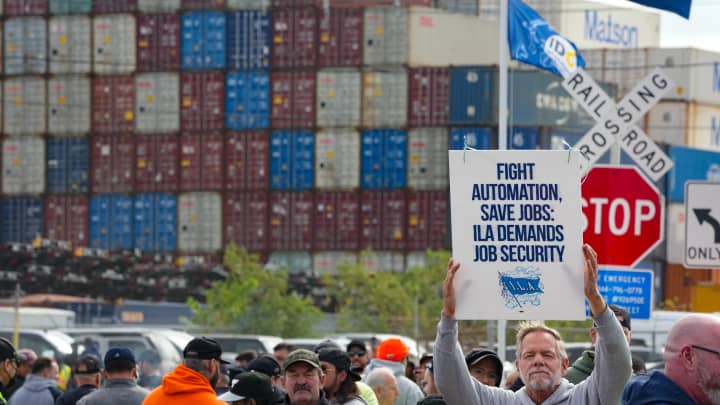New York – After days of disruption that sent ripples through the global supply chain, members of the International Longshoremen’s Association (ILA) will return to work at U.S. ports on Friday. This decision comes after union representatives and the United States Maritime Alliance (USMX), which represents shipping lines, terminal operators, and port authorities, struck a tentative agreement on wage increases late Thursday. The union had been on strike since early Tuesday morning, causing a significant halt in the flow of imports and exports through key U.S. ports, from Maine to Texas.
A source familiar with the discussions revealed that the agreement includes a substantial wage increase of $4 per hour each year over the six-year duration of the contract. This translates to a first-year raise of more than 10% on the current top wage of $39 per hour. Over the life of the contract, these annual raises will culminate in a 62% overall increase in wages.
The union also agreed to extend its expired contract with USMX until January 15, 2025. This extension allows both parties time to iron out the remaining details and submit the full agreement to a ratification vote by the union’s rank-and-file members. While workers return to their posts, final negotiations will continue, aiming for a full ratification before the new deadline.
A Presidential Endorsement
President Joe Biden commended the progress in a statement issued shortly after the tentative deal was announced, praising both the ILA and the USMX for their efforts in reaching a historic wage agreement.
“Today’s tentative agreement on record-setting wages and the extension of the collective bargaining process represents critical progress toward a strong contract,” President Biden stated. “I congratulate the dockworkers from the ILA, who have sacrificed so much to keep our ports open during the pandemic. I also applaud the US Maritime Alliance for their commitment to putting a strong offer on the table.”
The president, along with Vice President Kamala Harris and Secretary of Transportation Pete Buttigieg, had been advocating for a fair deal that adequately reflected the enormous profits shipping companies reaped in the aftermath of the pandemic, urging USMX to negotiate in good faith. The Biden administration refrained from using its authority under the Taft-Hartley Act to end the strike, standing by its commitment not to interfere in the collective bargaining process.
Labor Secretary’s Role in the Deal
Acting Secretary of Labor Julie Su played a critical role in mediating the discussions. She was present in New Jersey as the negotiations entered their final stages. Su had previously been instrumental in securing a deal in 2023 between West Coast port workers, represented by the International Longshore & Warehouse Union, and the Pacific Maritime Association, resulting in a 32% pay increase over five years.
This week’s negotiations, which also involved Su’s guidance, echoed that earlier success, bringing the two sides to a tentative agreement that both leaderships have deemed fair. However, union members still need to vote on the deal. If they reject the agreement, the strike could resume, potentially intensifying the already widespread disruptions to supply chains.
Impact of the Strike
The port workers’ strike came at a critical moment, with the busy holiday season just weeks away. Business groups, especially those relying on containerized imports, have expressed growing concern about the potential ripple effects on the economy. The strike affected everything from fresh produce to luxury imports, and economists warned that prolonged disruptions could lead to rising prices for consumers, especially as businesses scramble to stock up before the holidays.
For days, ships had been left stranded at sea, unable to offload goods. Businesses reliant on exports saw their overseas sales come to a standstill, leaving a host of American industries in limbo. The swift resolution of the strike now offers a reprieve, but the uncertainty remains until the union votes to ratify the deal.
The dockworkers’ strike also shed light on the broader challenges faced by the shipping industry, which saw profits soar during the pandemic. Analysts estimate that from 2020 to 2023, the industry amassed profits exceeding $400 billion—more than it had earned in total since the advent of containerization in 1957. These profits sparked labor unrest as workers, many of whom had worked tirelessly throughout the pandemic, sought to secure a larger share of the earnings.
The Road Ahead
As negotiations continue, there are still some unresolved issues between the union and USMX. Before the strike began, USMX had proposed a 50% raise over six years, or an average increase of $3 per hour each year. However, ILA President Harold Daggett said the union had countered with a demand for a $5 per hour increase each year, which would have resulted in a 77% overall wage hike. Although the union initially considered a compromise suggested by the Biden administration of $4 per hour, tensions flared when USMX returned with a revised offer.
The strike’s impact on the economy serves as a reminder of how critical dockworkers are to keeping the country’s supply chain functional. Even with a tentative deal in place, the uncertainty surrounding the vote looms large. If the workers reject the agreement, the U.S. could face another major disruption that would leave businesses scrambling for alternative solutions just as the holiday season kicks into gear.
As the shipping industry grapples with these labor challenges, the tentative deal offers a glimmer of hope for both the workers and the businesses that rely on the smooth operation of the country’s ports. Now, all eyes are on the union’s rank-and-file as they prepare to cast their votes on whether to accept the terms of the new contract. The next steps in this high-stakes negotiation will determine whether the labor peace that the country’s supply chains depend on will hold.






